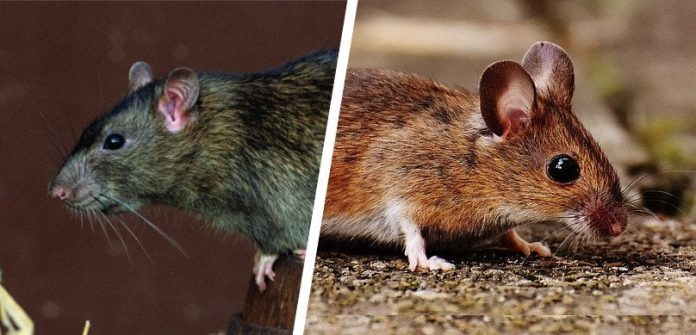There’s more to rodents than there seems. There are a lot of similarities between rats and mice, yet there are a few things that make them different from each other. Rats weigh around three times more than mice. Additionally, mice have a strong sense of smell and can be easily trained to operate machinery. We have even seen them playing video games! Here are the 6 curious differences between rats and mice.
# 1 Physical Appearance
Although we’re against body shaming and consider all rodents beautiful, we can’t deny that specific physical characteristics set mice apart from rats. For example, mice usually reach a length of 3 to 10 cm and weight of 12 to 45 grams, while a black rat is between 16 and 24 cm long and weighs between 150 and 200 g. Mice are recognisable by their large ears, long, thin hairy tails, short hair, and lighter-coloured bellies. Black rats have large ears, pointed noses, and slender bodies. Their tails are generally longer than their head and body. Brown rats can reach up to 40 cm, but their tails are shorter than their body. You can also tell them apart by their small ears, blunt nose, and thicker body.
# 2 Living Conditions
If cartoons have taught us anything, it’s that mice have their own dwellings in walls, behind an elaborate entrance, and that’s surprisingly accurate. Mice prefer areas such as cavities in walls, behind fridges, and under floorboards to set up their abodes. Although they can be quite the climbers, they usually prefer to nest in burrows and on the ground. Brown rats also prefer living on the ground and in buildings. They are the typical sewer dwellers, sometimes training mutant turtles. However, it is not rare to encounter brown rats outdoors, too. They are often found in gardens, under deckings, garden sheds, or in compost heaps and garages. Black rats are extremely agile and use this quality to set up their homes high in buildings, under roofs or even in the trees! An identity crisis, perhaps?
# 3 Eating Habits
Mice are omnivores and will eat anything, including their own tails and faeces if they’re starving. In not such extreme circumstances, they prefer carbohydrates, like grains, seeds, and fruit. That’s why mice control experts advise storing cereal in plastic, air-tight containers as a preventative measure. Like mice, brown rats also enjoy munching on cereals and will seek food in the same place the way mice do. Black rats, however, do not have a preferred spot for foraging, which makes baiting harder. Mice will drink about 3 ml of water a day, black rats need about 30 ml, and brown rats can drink up to 60 ml, so they set up their colony as close to a water source as possible.
# 4 Breeding Habits
One of the most severe concerns when it comes to pest control and rodents is the extremely fast rate at which they multiply. A fully mature female mouse can give birth to 7 – 8 litters a year, and each litter can have between 4 to 16 pups. Mice reach maturity at about 8 – 12 weeks. It takes 7 – 8 weeks for black rats and 10 – 12 weeks for brown rats to reach maturity. Both species of rat can have anywhere between 3 – 6 litters per year.
# 5 History
Although brown rats are also known as Norway rats, their origin can be traced back to China. They set out for world domination by following humans on trade routes and are now the most common rat species in Europe and North America. Historical evidence shows that humans have known mice since ancient times. The Romans obviously had a hard time differentiating between mice and rats and had no internet to give them a list of all the characteristics. So, not much effort was put into naming them – they called rats Mus Maximus (big mouse) and mice Mus Minimus (little mouse).
# 6 Droppings
Now, although this is not a very pleasant thing to discuss and observe, droppings are a very reliable way to identify whether you’re dealing with mice or rat infestation. Mice produce about 80 droppings a day, and they are often found scattered randomly during an infestation. They are black, about 3 – 8 mm long, have a granular shape, and are usually found near their nesting sites. Although rats are much bigger than mice, they produce a lot smaller and fewer droppings than mice. They are roughly around 1 – 2 mm and, depending on the species, can have the shape of a banana (for black rats) or a grain of rice for brown rats. Rats usually produce around 40 brown-coloured droppings per day.
Final Thoughts
There are a lot of differences between rats and mice. While both rodents will eat almost anything, rats are more likely to devour your food supplies and trash than to dine on the same food you do. Mice are more likely to be found dining on garbage than in it. So, how can you tell the difference between rats and mice? There’s a good chance you do. But if you’ve never really thought about it, this blog post is here to help.





